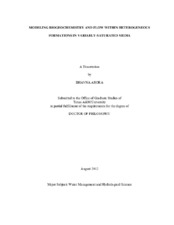| dc.description.abstract | This dissertation focuses on understanding the complex interactions between hydrological and geochemical processes, and specifically how these interactions are affected by subsurface heterogeneity across scales. Heterogeneity in the form of macropores and fractures provide preferential flowpaths and affect contaminant transport. Biogeochemical processes are also strongly affected by such heterogeneities. Any lithological layering or interface (e.g. plume fringe, wetland-aquifer boundary, etc.) increases biogeochemical activity around that interface. Hydrologic conditions, rainfall events, drainage patterns, and pH variations are also dominant controls on redox processes and thereby affect contaminant distribution and migration. An inherent limitation of modeling fate and transport of contaminants in the subsurface is that the interactions among biogeochemical processes are complex and non-linear. Therefore, this research investigates the effect of hydrological variations and physical heterogeneity on coupled biogeochemical processes across column and landfill scales.
Structural heterogeneity in the form of macropore distributions (no macropore, single macropore, and multiple macropores) in experimental soil columns is investigated to accurately model preferential flow and tracer transport. This research is crucial to agricultural systems where soil and crop management practices modify soil structure and alter macropore densities. The comparison between deterministic and stochastic approaches for simulating preferential flow improved the characterization of interface parameters of the dual permeability model, and outlined the need for efficient sampling algorithms or additional datasets to yield unique (equifinal) soil hydraulic parameters.
To evaluate the effect of heterogeneity on redox processes, repacked soil columns with homogeneous and heterogeneous (layered) profiles from soil cores collected at the Norman Landfill site, Oklahoma, USA were employed. Results indicate that heterogeneity in the form of textural layering is paramount in controlling redox processes in the layered column.
To evaluate the effect of hydrologic conditions on redox processes, temporal data at the Norman landfill site was used. Results indicate that seasonal hydrologic variations exert dominant control over redox-sensitive concentrations.
An integrated MCMC algorithm was devised to upscale linked biogeochemical processes from the column to the field scale. Results indicate that heterogeneity and hydrologic processes are paramount in controlling effective redox concentrations at the Norman landfill site. | en |


